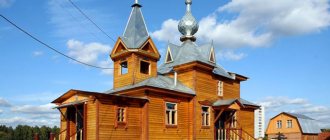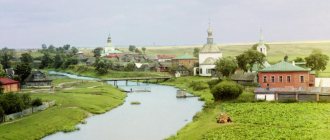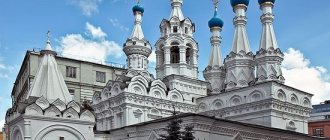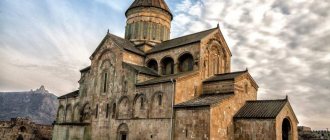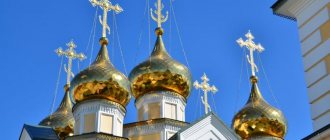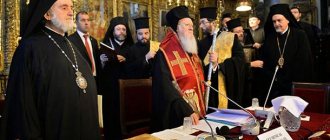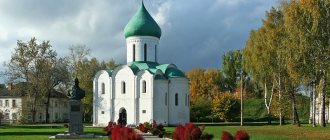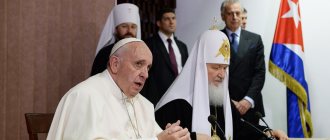October 7, 2016Anthropology, History
What do Armenian, Ethiopian and Indian Christians have in common, where did St. Christopher get his dog's head and where is the Ark of the Covenant located?
Author Lyudmila Zhukova
In 451, a church council was convened in the Byzantine city of Chalcedon. A pressing theological question was discussed: to what extent Jesus Christ was God and to what extent was he human? Most of the council participants insisted that in Christ two natures were united “inseparably and unmerged,” but this formulation did not satisfy everyone: some theologians argued that Jesus Christ has one nature—the divine-human.
Fourth Ecumenical Council, convened in 451 at Chalcedon. Fresco in the Church of St. Sozomen. Galata, Cyprus, 16th century Bridgeman Images / Fotodom
Despite the subtlety of this issue and the non-obvious difference for a person far from religion, the dispute led to a real split. Churches that did not accept the decision of the majority later received the name non-Chalcedonian, or ancient eastern, churches (now they are the Armenian, Coptic, Syrian, Malankara, Ethiopian and Eritrean, which separated from it in 1998). Opponents traditionally call them Monophysite (from Greek - “one nature”), but non-Chalcedonian Christians themselves do not accept this term and call themselves simply Orthodox. Each of these churches is unique: their temples, icons, priests’ attire and many traditions, at first glance, have nothing in common, but the most important thing - the basis of their faith - they have in common.
Armenian Church
1 / 2
Drawing on a tile in the Cathedral of St. James of the Armenian Church in Jerusalem Library of Congress
2 / 2
Armenian monastery Varagavank. 1910s Library of Congress
Osip Mandelstam aptly called Armenia “the younger sister of the land of Judea.” The territory of historical Armenia is literally a “biblical land”: Noah’s Ark found its berth “on the mountains of Ararat.” Ararat, although located in Turkey, is still a spiritual symbol of Armenia - even the pointed hoods in the vestments of the Armenian clergy are reminiscent of this.
According to legend, Christians appeared in Armenia in the 1st century thanks to the missionary activities of the apostles Thaddeus and Bartholomew. But the widespread spread of Christianity in Armenia began only with the preaching of St. Gregory the Illuminator in the 3rd–4th centuries. In 301, which entered the historical chronicles as the year of Christianization of Armenia, he baptized the Armenian king Trdat III. According to legend, Trdat, who at first did not have a very favorable attitude towards Christians, was converted with the help of a miracle. It all started with the fact that he desired the beautiful girl Hripsime, who fled to Armenia from the harassment of the Roman emperor Diocletian. Having rejected the Armenian king after the Roman Caesar, Hripsime was executed along with 32 friends, and Trdat, according to the Armenian historian Agafangel, turned into a boar. Saint Gregory the Illuminator, who by that time had been languishing in prison for 14 years, healed the king, and this was the main argument in choosing faith. Since then, Gregory has been the most revered saint of the Armenian Church; his day is celebrated four times a year.
At the beginning of the 5th century, the Armenian scientist, writer, missionary Mesrop Mashtots created the Armenian written language and, together with Catholicos (head of the Armenian Church) Sahak Partev, translated the Bible into Armenian.
Armenian churches are a square or rectangular building with a cone-shaped roof. The altar is separated from the rest of the temple space by a curtain, and not by an iconostasis, as in Orthodox churches. There are few icons in the temple; the image of the Mother of God is always placed in the altar. Particularly revered are khachkars - stone crosses with intricate patterns that have become the main symbol of the Armenian Church.
The Armenian Church has preserved a unique rite of matah - the consecration of salt, which is fed to the animal being sacrificed and sprinkled on the sacrificial meat. A male animal (bull, ram or rooster) is slaughtered outside the church fence, and the function of the priest is only to consecrate the salt - he does not take part in the sacrifice itself. The meat is eaten and distributed to the poor on the same day. Matah is performed on various occasions - as a sign of gratitude to God or in fulfillment of a vow. It is obvious that the basis of this ritual is the pre-Christian practice of sacrifice, preserved thanks to reinterpretation in the Christian spirit.
Another unique tradition of the Armenian Church is to use wine without adding water for the sacrament of communion. However, other non-Chalcedonian churches dilute the wine with water, as do the Catholics and Orthodox.
Coptic Church
1 / 2
Saint Christopher. 1685 Byzantine and Christian Museum, Athens Getty Images
2 / 2
Anubis. Illustration from A Traveler's Guide to Lower and Upper Egypt. 1888 Wikimedia Commons
Copts are the name given to the descendants of the ancient Egyptians who converted to Christianity. According to church tradition, the first preacher of the new faith in the Land of the Pharaohs was the author of one of the Gospels, the Apostle Mark. By the beginning of the 4th century, a significant part of the indigenous population of Egypt professed Christianity and fought against the pagans: they destroyed Egyptian temples, smashed statues of gods, and mocked ancient customs. One of the stories that has come down to us tells how a certain monk spent the night in a tomb, and instead of a pillow he put a mummy under his head.
However, the new Christian culture not only mocked the heritage of its ancestors, but also creatively reworked it. The symbol of this synthesis is the image of the Christian Saint Christopher - cynocephalus (dog-headed). According to one version of the legend, the Christian youth Christopher was so handsome that women, absorbed in the contemplation of his appearance, did not hear a word of his sermon. Then Christopher asked God to deprive him of his beauty, as a result of which he became a dog-head. Art historians believe that the iconography of this saint was influenced by the image of the god Anubis with the head of a jackal. And the images of Isis - the goddess of fertility, a symbol of femininity and motherhood - holding her son in her arms influenced the iconography of the Mother of God with the Child Jesus. Some ancient Egyptian symbols received a new interpretation: the sign of life ankh was reinterpreted as a cross; images of fish - as a symbol of Jesus Christ. The synthesis of Christianity and the religion of Ancient Egypt is most clearly manifested in texts related to magical conspiracies and continuing ancient Egyptian magical practices. “Hor, Horus, For, Eloe, Adonai, Iao, Hosts, Michael, Jesus Christ! Help us and this house. Amen” - in this prayer, not only Christ and Christian saints are called to help, but also the Egyptian gods and even the Jewish Host (there was a fairly significant Jewish community in Egypt). These conspiracies had different purposes - to bewitch a girl, destroy an enemy, or neutralize an evil dog.
Most Coptic temples take the form of a basilica and are usually topped by a dome or rows of identical domes. The interior decoration of the temple includes paintings, icons and carpets - you are required to take off your shoes when entering the temple. This tradition probably arose under the influence of the Muslim environment: it is also customary to enter a mosque without shoes. One of the most popular Coptic saints is St. George; there is a throne in his honor or an icon in every Coptic temple.
Ethiopian Church
1 / 2
Trinity, symbols of the evangelists and the temptation of Adam and Eve. Sketch of a fresco of an Ethiopian priest. 1940s British Museum
2 / 2
Prayer for the cup and the sleeping apostles in the Garden of Gethsemane. Sketch of a fresco of an Ethiopian priest. 1940s British Museum
According to legend, the spread of Christianity in Ethiopia began in the 4th century, when Saint Frumentius, shipwrecked off its shores, managed to convert the local king to Christianity, and in 330 he declared his faith the state religion. The work of Saint Frumentius was continued by the “nine saints” - Syrian Christians (Western Syria was part of Byzantium), who fled to Ethiopia at the end of the 5th century due to persecution associated with rejection of the decisions of the Council of Chalcedon. This is probably why the Ethiopian Church, like the Syrian, Coptic and Armenian, adheres to non-Chalcedonian theology. The “Nine Saints” translated the Bible into ancient Ethiopian, and in the 6th century, according to contemporaries, Ethiopia was already definitively a Christian country.
Ethiopian Christianity is distinctive. On the one hand, church customs are strongly influenced by Judaism: Ethiopian Christians practice circumcision of boys (like the Copts), observe some Jewish food prohibitions and, unlike other non-Chalcedonian churches, celebrate not only Sunday, but also Saturday. On the other hand, Ethiopian worship contains elements of local African traditions: in the Ethiopian church there is a unique order of dabtara priests who perform sacred hymns and ritual dances to the beat of drums.
Until the 20th century, the Ethiopian Church was subordinate to the Egyptian Coptic Church: the first Ethiopian patriarch appeared only in 1959. Ras , played a big role in this . Tafari, the last emperor of Ethiopia (1930–1936, 1941–1974), who at his coronation took the name Haile Selassie - "the power of the Trinity" - and bore the long title "Lion of the Tribe of Judah, Chosen of God, King of Kings." This last member of the Solomonid dynasty to be ordained as a deacon ironically became the target of a well-known cult not associated with the Ethiopian Orthodox Church: Rastafarianism. The cult of the emperor arose among Ethiopian emigrants on the island of Jamaica, and then gained popularity in other countries thanks to the special Rastafarian musical style - reggae. This musical movement emerged in the 1960s: its most famous representative was Rastafarian Bob Marley. Rastafarianism had a pronounced racial character: its followers argued that the Jewish people, and therefore Jesus Christ and the apostles, were black, the Land of Promise was identified with Ethiopia, and King Haile Selassie was considered the incarnation of God on earth.
Ethiopian temples were built in several styles, but the most famous are the medieval rock-cut temples of the city of Lalibela. In the altar of each temple there is a tabot - a special wooden box symbolizing the biblical Ark of the Covenant. Tabot is taken out of the church on the eve of the celebration of Epiphany - a solemn procession accompanies him to the local reservoir, and then, after spending the night in a camp tent, he returns to his place.
The special cult of the Ark of the Covenant, which has no analogue in other Christian churches, is explained by the fact that, according to Ethiopian legend, Menelik I, at the instigation of the angel of the Lord, took possession of the Ark of the Covenant by cunning and took it to Ethiopia. When the ark secretly left Jerusalem, its inhabitants, according to Ethiopian chroniclers, sensed something was wrong: “And although at that time they still did not know that the Ark of the Covenant had been taken away from them, their hearts were not mistaken, and they wept bitterly. There was no house where there were no people crying, as well as animals; dogs howled, donkeys brayed, and the tears of all those who remained were mixed together.” Ethiopians believe that the ark is kept in the city of Axum, in the temple of Our Lady of Zion, although no one except specially admitted clergy has ever seen it.
Literature
- Branitsky A. G., Kornilov A. A.
[www.fmo.unn.ru/files/2013/01/Religii-regiona.pdf Religions of the region]. - N. Novgorod: Nizhny Novgorod State University named after N. I. Lobachevsky, 2013. - 305 p. - Bishop Porfiry (Uspensky), “Christian East” (Kyiv, 1873);
- Voznesensky, “Monophysites in Abyssinia” (in “Spirit. Conversation” 1863);
- John Nason Nale, “The Patriarchate of Alexandria” (L., 1847);
- Tromler, "Abbild, der Jacobitischen Kirche" (Jena, 1749);
- Bibliothecae Copto-Jacobinicae specimen" (Lpts., 1767);
- Wansleb, “Histoire de L'Eglise d'Alexandrie, que nous appelons des Jacobites” (P., 1677);
- Silbernagel, “Verfassung u. gegenwärtiger Bestand sämmtlicher Kirchen des Orients" (1865);
- Bishop of Turkestan Sophony, “Modern life and liturgy of the Jacobites and Nestorians” (St. Petersburg, 1876);
- Archpriest Petrov, “Eastern Christian Societies” (with atlas, St. Petersburg, 1876).
- Peoples and religions of the world. Encyclopedia. (M., 2000)
- Seleznev N.N., [east-west.rsuh.ru/article.html?id=67105 Interpretations of the origin of the name “Jacobites” among medieval Arabic-speaking Egyptian authors
] // Bulletin of the Russian State University for the Humanities: Series “Oriental Studies, African Studies” 20(100) ( 2012), pp. 153-168.
Syriac Orthodox Church
Ignatius Ilia III (center), Patriarch of Antioch and all the East. Jerusalem, 1920s In 1987, 55 years after his death, he was canonized by the Syrian Orthodox Church.
Bridgeman Images / Fotodom Christianity spread and took hold in Syria very early. The New Testament tells that on the road to the Syrian city of Damascus, the resurrected Jesus Christ appeared to the Apostle Paul; in Damascus, Paul was healed of the blindness that had struck him and baptized. This is where his missionary work began.
In the Syrian city of Antioch, followers of Jesus Christ first began to call themselves Christians. There is a popular legend among Syrian Christians that the East Syrian kingdom of Osroene became Christian back in the 1st century, and its ruler, King Abgar, was in correspondence with Jesus Christ and even invited him to move to the capital of Osroene, Edessa: “My city is very small, but venerable, and It’s enough for both of us.”
An important role in the spread of Christianity among the Syrians was played by the fact that Jesus and his disciples, in fact, spoke Aramaic, one of the dialects of which is Syriac. In the 4th century, the Bible was translated into Syriac. This translation is called the Peshitta (in Syriac it means “generally accepted text”) and is the official Holy Scripture of the Syro-Jacobites (more about them below).
The refusal of some Syrians to accept the decisions of the Council of Chalcedon subsequently led to a split in Syriac Christianity. The Syrians, who agreed with the decisions of the council and thereby showed loyalty to the Byzantine emperor, began to be called Melkites - “royal”, and their opponents - Jacobites, named after Bishop Jacob Baradai, who in the 6th century led the opponents of Chalcedon and created an independent church hierarchy. An energetic organizer, Jacob was an ascetic: his nickname Baradai (“felt”) refers to the fact that he wore a hair shirt on his body.
In the Syro-Jacobite Church, sourdough bread is used for communion: according to legend, it has been passed down from generation to generation since apostolic times. It is interesting that the Syro-Jacobites (like the Copts) make the sign of the cross with one finger - from left to right, clearly affirming the unity of the nature of Jesus Christ.
Current state
The primate of the church from September 14, 1980 to March 21, 2014 was Patriarch Moran Mor Ignatius Zacca I Ivas.
On March 31, 2014, Ignatius Ephraim II (Kerim) was elected as the new primate of the Church.[2]
The Church has about 26 dioceses. The church has approximately 2,250,000 members worldwide, including 1,200,000 members in India (Syrian Orthodox Church of India). In Syria the number of believers is about 680,000 and 5,000 in Turkey (numbers in Iraq and Israel are unknown). In Lebanon there are up to 50,000 members. There are about 100,000 members in Sweden, 80,000 members in the USA, 50,000 in Germany, 15,000 in the Netherlands, and a large, unknown number in North, South America and Australia.
The church has two seminaries, as well as numerous colleges and other educational institutions. The church also has an international Christian educational center.
